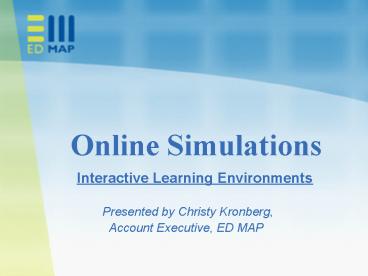Online Simulations - PowerPoint PPT Presentation
1 / 23
Title:
Online Simulations
Description:
... 45 minutes of lecture - or worse they begin to play solitaire on their laptops. ... Real world challenges for decision-making. Several decision scenarios ... – PowerPoint PPT presentation
Number of Views:35
Avg rating:3.0/5.0
Title: Online Simulations
1
Online Simulations
- Interactive Learning Environments
- Presented by Christy Kronberg,
- Account Executive, ED MAP
2
Agenda
- Why Simulations
- Learning Outcomes
- Features of a Good Simulation
- Challenges in Simulation Development
- ED MAPs Simulation Library
- Question and Answers
3
Why Simulations
Gen-X and Gen-Y learners have grown up playing
computer games, and demand a fast-paced,
interactive learning environment.
4
Why Simulations
- Indeed Harvard professors are complaining
that law students begin to fidget after 45
minutes of lecture - or worse they begin to play
solitaire on their laptops. Many instructors are
wondering to what degree computer games can be
part of the solution. . . Perhaps the question
should be, can training programs directed at Gen
X and beyond succeed if they ignore simulations?
The answer not very likely. - Aldridge, Clark. (2002). A Field Guide to
Educational Simulations. Retrieved November 8,
2006, from http//www.simulearn.net/pdf/astd.pdf.
5
Why Simulations
- Simulations Provide
- Active Learning Environments
- Instant Feedback on Decisions
- Learner Motivation
- Immersion in Contextual Environment
- Safe Place to Explore Ramifications
- of Decisions
6
Active Learning
. . . students at all levels tend to perceive
substantial value for learning in general as
well as relative to work experiences or any other
educational activities Rommes, George.
(2004). Perceptions of the Value of Microworld
Simulation. Simulation and Gaming, 35, 433.
7
Learning Benefits
- Simulations Provide
- Active Learning Environments
- Instant Feedback on Decisions. . .
8
Feedback on Decisions
- Providing timely, effective feedback to learners
on their strategies - is an essential part of any learning process.
- Laurillard D. (2006). Rethinking University
Teaching a framework for the effective use of
educational technology.
9
Learning Benefits
- Simulations Provide
- Active Learning Environments
- Instant Feedback on Decisions
- Learner Motivation . . .
10
Learner Motivation
We found the (simulations) program motivated
all learners, including lower achievement
students typically uninterested in classroom
activities. Morisette, Karlyn. (2003).
Exploring New Learning Technologies- An
Interview with Professor Chris Dede. HGSE News,
2. Retrieved November 6, 2006 from
http//www.gse.harvard.edu/news/features/dede0301
2003.html.
Through surveying students, we noticed there was
a tendency to re-run simulations in an attempt to
get better results. This shed light on the fact
that the simulations were really engaging.
Sharkey, Mike. (2006). Simulations Through
rEsource at the University of Phoenix. Campus
Technology, 2. Retrieved November 6, 2006 from
http//www.campus- technology.com/news_article.asp
?id10356typeid156.
11
Learning Benefits
- Simulations Provide
- Active Learning Environments
- Instant Feedback on Decisions
- Learner Motivation
- Immersion in Contextual Environment. . .
12
Contextual Environment
- These immersive environments use authentic
contexts, activities and assessmentThe result is
a powerful pedagogy that allows for immersion and
intense, extended experiences with problems and
contexts similar to the real world - Oblinger, Diana. (2006). Simulations,
Games and Learning. Educause 3. Retrieved
November 8, 2006 from http//www.educause.edu/ir/
library/pdf/ELI3004.pdf.
13
Learning Benefits
- Simulations Provide
- Active Learning Environments
- Instant Feedback on Decisions
- Learner Motivation
- Immersion in Contextual Environment
- Safety Nets
14
Safe Learning Environment
- Simulations also offer the learner an
opportunity to test new knowledge, strategies,
skills and techniques in a virtual risk-free
environment. Many educators believe that
experiencing failure such as this is an essential
component in the learning process. - Galarneau, L. (2005). Proceedings from Games,
Simulations and the Construction of Knowledge,
Digital Games Research Association Conference
05 Authentic Learning Experiences Through
Play. Vancouver, British Columbia, Canada.
Retrieved November 6, 2006 from
http//lisa.socialstudygames.com/digra_galarneau_
final.pdf.
15
Learning Outcomes
Soft Skills Enhancement Sims help learner build
knowledge of specific concepts through
discovery, experimentation and reflection. Critic
al Thinking Advancement
16
Critical Thinking Skills
- Jan Cannon-Bowers, previously senior scientist
for training systems for the U.S. Navy said that
her research suggests, Simulation based and game
based training can teach complex, higher order
skills. - Gaming for a Smarter America. (2005).
PHYSORG-Science, Technology, Physics, Space News,
1.
17
Features of a Good Simulation
- High intensity interactivity and feedback.
- Specific goals and established procedures.
- Continually challenging -
- not overwhelming or boring.
- Appropriate tools and aids which fit task
well, so as not to distract from learning. - Provides immersion into environment
while learner performs task.
18
Simulation Challenges
- Significant investment of resources
- Long planning and production time
19
ED MAPs Library
Over 150 Titles Available
20
Simulation Features
- Real world challenges for decision-making
- Several decision scenarios per simulation
- Instant feedback on decisions
- Sophisticated graphics and user interface
- Textbook independent based on learning
objectives - Incorporates easily
- each simulation supported by faculty guide
21
Online Simulations Demonstration
- http//www.edmap.biz/simulations
22
Simulation Adoption
Notify students
Agree to adopt and add to syllabus
Create account and review simulations and guides
Browse library and select simulations to
review
23
Questions and Answers
24
Thank Youwww.edmap.biz/simulationsckronberg_at_edma
p.biz































